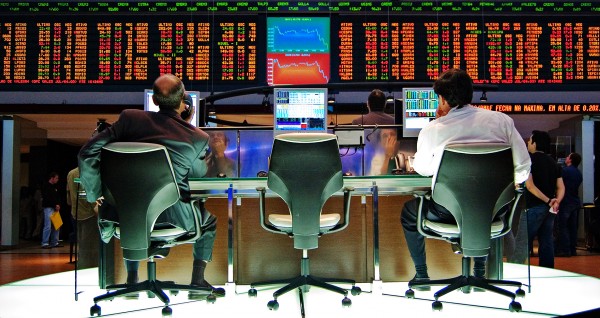 Thirty years ago, on Monday 19 October 1987, stock markets around the world tumbled. The day has been dubbed ‘Black Monday’. Wall Street fell by 22% – its biggest ever one-day fall. The FTSE 100 fell by 10.8% and by a further 12.2% the next day.
Thirty years ago, on Monday 19 October 1987, stock markets around the world tumbled. The day has been dubbed ‘Black Monday’. Wall Street fell by 22% – its biggest ever one-day fall. The FTSE 100 fell by 10.8% and by a further 12.2% the next day.
The crash caught most people totally by surprise and has never been fully explained. The most likely cause was an excessive rise in the previous three years, when share prices more than doubled. This was combined with the lack of ‘circuit breakers’, which today would prevent excessive selling, and a ‘herd’ effect as people rushed to get out of shares before they fell any further, creating a massive wave of destabilising speculation.
Within a few weeks, share prices started rising again and within three years shares were once again trading at levels before Black Monday.
 Looking back to the events of 30 years ago, the question many fund managers and others are asking is whether global stock markets are in for another dramatic downward correction. But there is no consensus of opinion about the answer.
Looking back to the events of 30 years ago, the question many fund managers and others are asking is whether global stock markets are in for another dramatic downward correction. But there is no consensus of opinion about the answer.
Those predicting a downward correction – possibly dramatic – point to the fact that stock markets, apart from a dip in mid-2016, have experienced several years of growth, with yields now similar to those in 1987. Price/earnings ratios, at around 18, are high relative to historical averages.
What is more, the huge increases in money supply from quantitative easing, which helped to inflate share prices, are coming to an end. The USA ceased its programme three years ago and the ECB is considering winding down its programme.
Also, once a downward correction starts, destabilising speculation is likely to kick in, with people selling shares before they go any lower. This could be significantly aggravated by the rise of electronic markets with computerised high-frequency trading.
However, people predicting that there will be little or no downward correction, and even a continuing bull market, point to differences between now and 1987. First, the alternatives to shares look much less attractive than then. Bond yields and interest rates in banks (at close to zero), unlike in 1987, are much lower than the dividend yields on shares (at around 4%). Second, there are circuit breakers in stock markets that suspend dealing in cases of large falls.
But even if there is a downward correction, it will probably be relatively short-lived, with the upward trend in share prices continuing over the long term. If you look at the chart above, you can see this trend, but you can also see periods of falling share prices in the late 1990s/early 2000s and in the financial crisis of 2008–9. Looking back to 1987, it seems like a mere blip from the perspective of 30 years – but it certainly didn’t at the time.
Articles
Three decades since Black Monday – are markets on the verge of another tumble? The Telegraph, Lucy Burton (19/10/17)
Black Monday: 30 years on from the 1987 crash Citywire, Michelle McGagh (19/10/17)
30 Years Ago: Lessons From the 1987 Market Crash U.S.News, Debbie Carlson (12/10/17)
Black Monday: Can a 1987-style stock market crash happen again? USA Today, Adam Shell (19/10/17)
Black Monday anniversary: How the 2017 stock market compares with 1987 MarketWatch, William Watts (19/10/17)
30 years after Black Monday, could stock market crash again? MarketWatch, William Watts (19/10/17)
 The Crash of ’87, From the Wall Street Players Who Lived It Bloomberg, Richard Dewey (19/10/17)
The Crash of ’87, From the Wall Street Players Who Lived It Bloomberg, Richard Dewey (19/10/17)
Questions
- Explain what are meant by ‘bull markets’ and ‘bear markets’.
- Share prices are determined by demand and supply. Identify the various demand- and supply-side factors that have led to the current long bull-market run.
- What caused the Black Monday crash in 1987?
- For what reasons may global stock markets soon (a) experience, (b) not experience a downward correction?
- Distinguish between stabilising speculation and destabilising speculation on stock markets.
- What determines when a downward correction on stock markets bottoms out?
- Explain how stock market circuit breakers work. Can they prevent a fundamental correction?
- Does the rise in computerised trading make a stock market crash more or less likely?
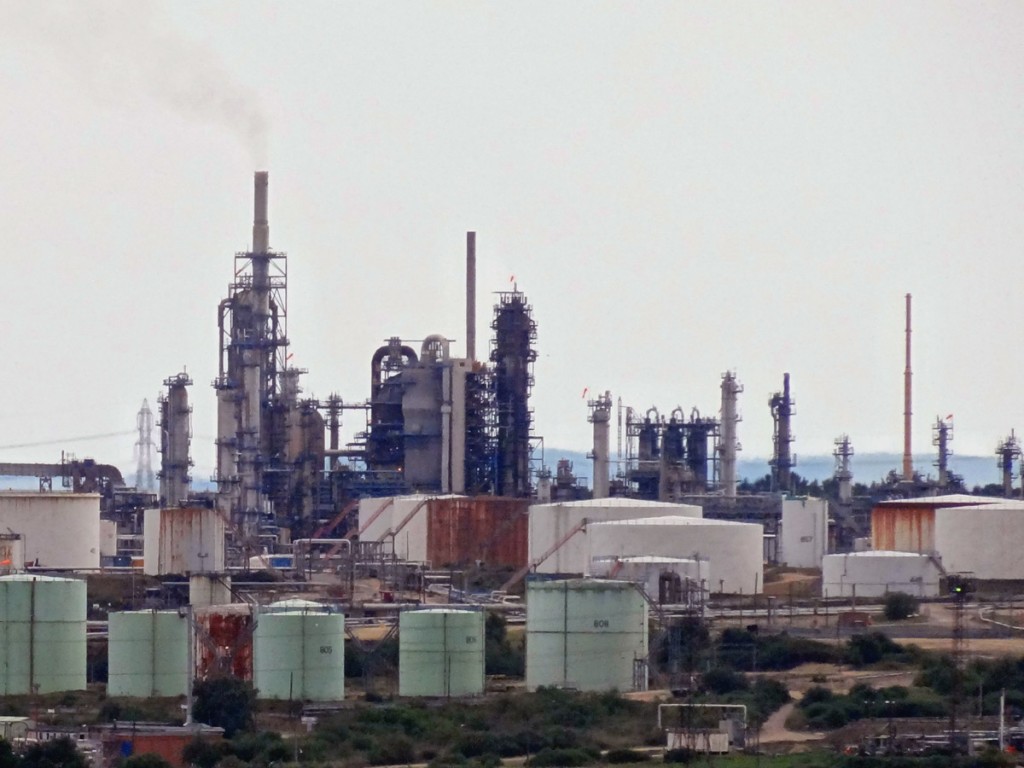 Oil prices are determined by demand and supply. Changes in oil prices are the result of shifts in demand and/or supply, with the size of the price change depending on the size of the shift and the price elasticity of demand and supply.
Oil prices are determined by demand and supply. Changes in oil prices are the result of shifts in demand and/or supply, with the size of the price change depending on the size of the shift and the price elasticity of demand and supply.
Some of the shifts are long term, with the price of oil varying from year to year or even moving in a particular direction for longer periods of time. Thus the opening up of new supplies, such as from fracking wells, can lead to a long-term fall in oil prices, while agreements by, say, OPEC to curb output can lead to a long-term rise in prices (see the blogs The oil see-saw, OPEC deal pushes up oil prices and An oil glut).
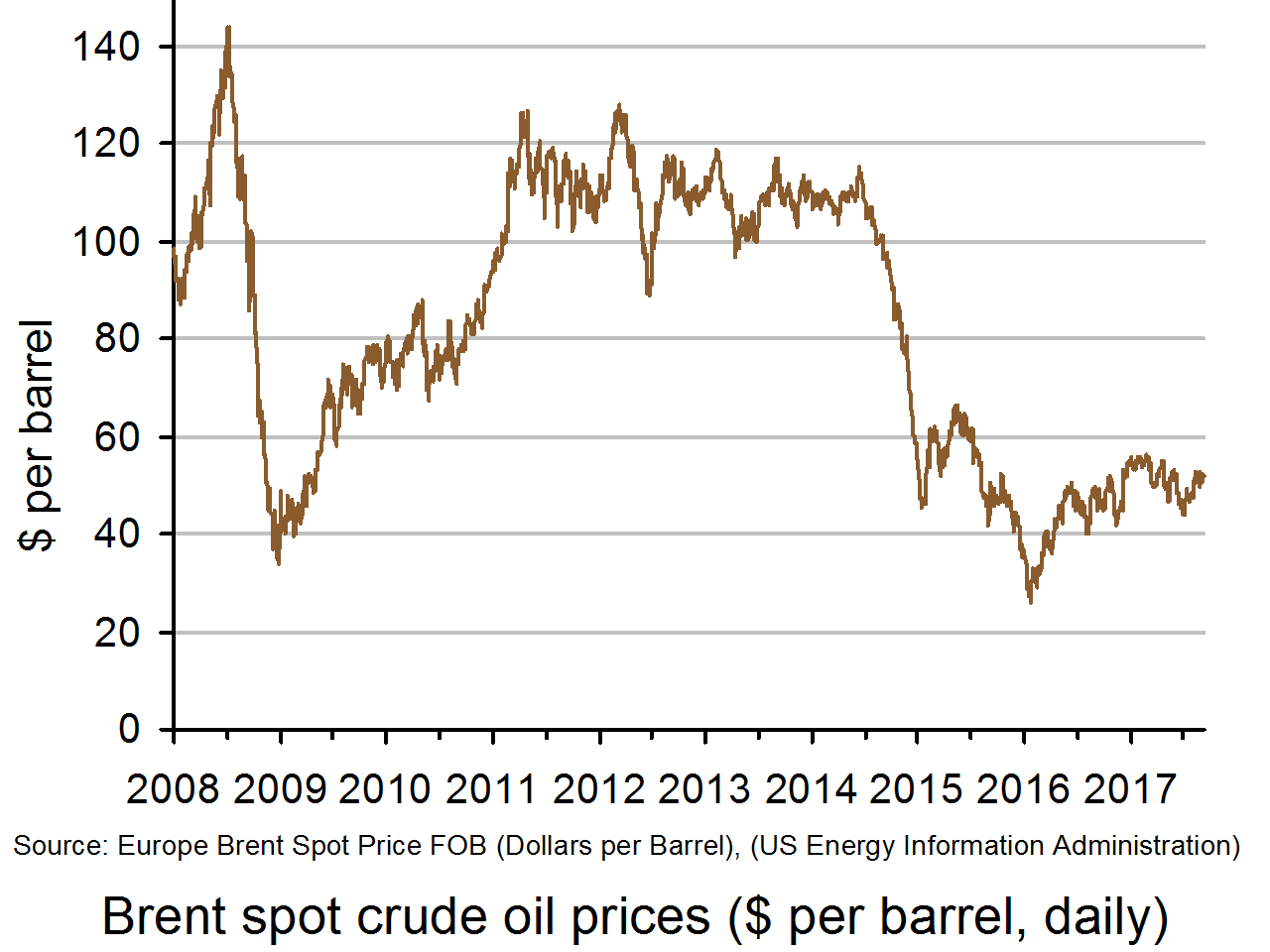
Medium and long-term price movements can also reflect medium and long-term changes in demand, such as a recession – oil prices fell dramatically as the world economy slid into recession in 2008/9 and then recovered as the global economy recovered.
Another long-term factor is the development of substitutes, such as renewable energy, which can reduce the demand for oil; another is developments that economise on power, such as more fuel-efficient vehicles and machines.
But oil prices do not just reflect these long-term movements in demand and supply. They also reflect daily and weekly movements as demand and supply respond to global and national events.
Two such events occurred at the end of August/beginning of September this year. The first was Hurricane Harvey. Even though it was downgraded to a tropical storm as it made landfall across the coast of the Gulf of Mexico, it dumped massive amounts of rain on southern Texas and Louisiana. This disrupted oil drilling and refining, shutting down a quarter of the entire US refining capacity.  The initial effect was a surge in US oil prices in late August as oil production in much of Texas shut down and a rise in petrol prices as supplies from refineries fell.
The initial effect was a surge in US oil prices in late August as oil production in much of Texas shut down and a rise in petrol prices as supplies from refineries fell.
Then prices fell back again in early September as production and refining resumed and as it became apparent that there had been less damage to oil infrastructure than initially feared. Also the USA tapped into some of its strategic oil reserves to make up for the shortfall in supply.
Then in early September, the North Koreans tested a hydrogen bomb – much larger than the previous atom bombs it had tested. This prompted fears of US retaliation and heightened tensions in the region. As the Reuters article states:
That put downward pressure on crude as traders moved money out of oil – seen as high-risk markets – into gold futures, traditionally viewed as a safe haven for investors. Spot gold prices rose for a third day, gaining 0.9 per cent on Monday
Quite large daily movements in oil prices are not uncommon as traders respond to such events. A major determinant of short-term demand is expectations, and nervousness about events can put substantial downward pressure on oil prices if it is felt that there could be a downward effect on the global economy – or substantial upward pressure if it is felt that supplies might be disrupted. Often markets over-correct, with prices moving back again as the situation becomes clearer and as nervousness subsides.
Articles
U.S. crude edges higher, gasoline tumbles after Harvey Reuters, Libby George (4/9/17)
Global oil prices fall after North Korea nuclear weapon test Independent, Henning Gloystein (4/9/17)
Brent crude oil falls after North Korea nuclear test The Indian Express (4/9/17)
Oil prices remain volatile AzerNews, Sara Israfilbayova (4/7/17)
Questions
- What are the determinants of the price elasticity of demand for oil?
- Search news articles to find some other examples of short-term movements in oil prices as markets responded to some political or natural event.
- Why do markets often over-correct?
- Explain the long-term oil price movements over the past 10 years.
- Why is gold seen as a ‘safe haven’?
- If refineries buy oil from oil producers, what would determine the net effect on oil prices of a decline in oil production and a decline in demand for oil by the refineries?
- What role does speculation play in determining oil prices? Explain how such speculation could (a) reduce price volatility; (b) increase price volatility. Under what circumstances is (b) more likely than (a)?
 According to the Halifax house price index, house prices fell in the UK in the three months to April. This is the first quarterly fall since 2012. The Nationwide index (see below), shows that prices in April were 0.4% lower than in March (although the 3-month rate was still slightly positive).
According to the Halifax house price index, house prices fell in the UK in the three months to April. This is the first quarterly fall since 2012. The Nationwide index (see below), shows that prices in April were 0.4% lower than in March (although the 3-month rate was still slightly positive).
The fall in house prices reflects a cooling in demand. This, in turn, reflects a squeeze on household incomes as price rises begin to overtake wage rises. It also reflects buyers becoming more cautious given the uncertainty over the nature of the Brexit deal and its effects on the economy and people’s incomes.
The fall in demand is also driven by recent Bank of England rules which require mortgage lenders to limit the proportion of mortgages with a mortgage/income ratio of 4.5 or above to no more than 15% of their new mortgages. It is also affected by a rise in stamp duty, especially on buy-to-let properties.
Despite the fall in prices, this may understate the fall in demand relative to supply. House price movements often lag behind changes in demand and supply as people are reluctant to adjust to equilibrium prices. In the case of a falling market, sellers may be unwilling to sell at the lower equilibrium price, believing that a lower price ‘undervalues’ their property. Indeed, they may not even put their houses on the market. This makes prices ‘sticky’ downwards. The result is a fall in sales.
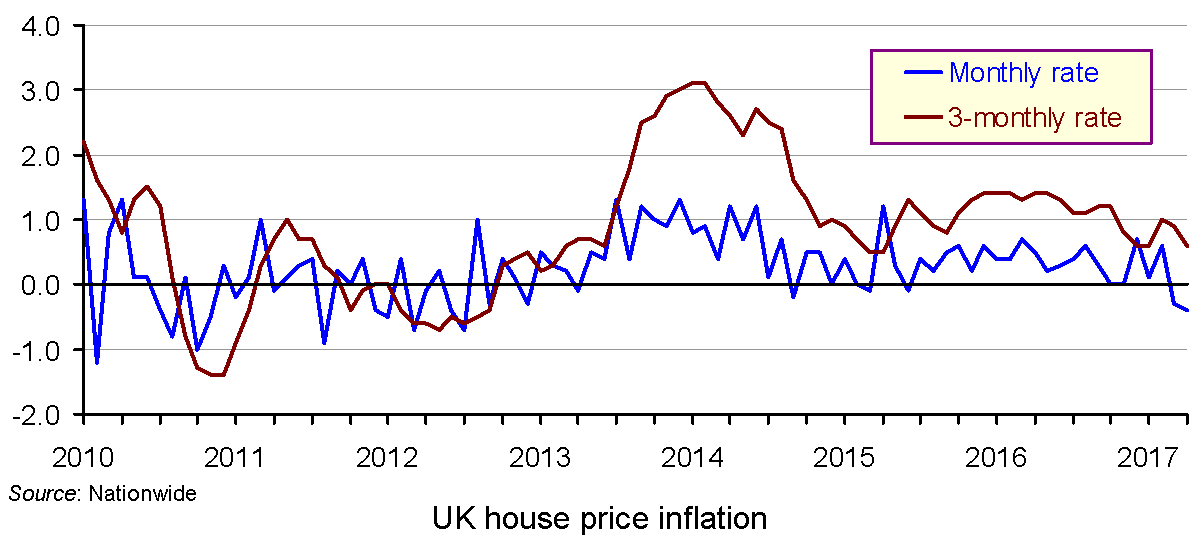
Eventually, such people will reluctantly be prepared to accept a lower price and prices will thus fall more. Once people come to expect price falls, supply may increase further as vendors seek to sell before the price falls even more. So we could well see further falls over the coming months.
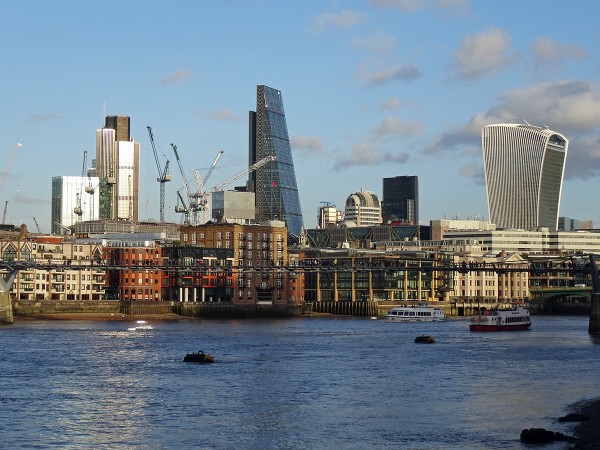 Lower house prices and falling sales is a picture repeated in many parts of the UK. It is particularly marked in central London. There, estate agents have begun to offer free gifts to purchasers. As The Guardian puts it:
Lower house prices and falling sales is a picture repeated in many parts of the UK. It is particularly marked in central London. There, estate agents have begun to offer free gifts to purchasers. As The Guardian puts it:
London estate agents have begun to offer free cars worth £18,000, stamp duty subsidies of £150,000, plus free iPads and Sonos sound systems to kickstart sales in the capital’s increasingly moribund property market. The once super-hot central London market has turned into a ‘burnt-out core’ according to buying agents Garrington Property Finders, prompting developers to offer ever greater incentives to lure buyers.
… Land Registry figures show that in the heart of the city’s financial district, average property prices plummeted from £861,000 at the time of the EU referendum to £773,000 in February, a decline of 15%, although in London’s outer boroughs prices are still up over the year.
But lower property prices are good news for first-time buyers, although some of the biggest falls have been in the top end of the market.
The fall in property prices may continue for a few months. But population is rising, and with it the number of people who would like to buy their own home. Once real incomes begin to rise again, therefore, demand is likely to resume rising faster than supply. When it does, house prices will continue their upward trend.
Articles
UK house prices in first quarterly fall since 2012 BBC News (8/5/17)
UK house prices fall again in April as buyers feel the pinch The Guardian, Angela Monaghan (28/4/17)
Buy a home, get a car free: offers galore as London estate agents struggle to sell The Guardian, Patrick Collinson (3/5/17)
London is now one of the five cities with the lowest house price growth in the UK City A.M., Helen Cahill (28/4/17)
London Housing Market Property Bubble Vulnerable To Crash The Market Oracle, Jan Skoyles (3/5/17)
A key indicator of a healthy housing market is flashing red in London Business Insider, Thomas Colson (29/5/17)
House Price Data
UK House Prices – links to various sites Economic Data freely available online – Economics Network
Questions
- Why are UK house prices falling?
- What determines the rate at which they are falling? How is the price elasticity of demand and/or supply relevant here?
- How does speculation help to explain changes in house prices? How may speculation help to (a) stabilise and (b) destabilise house prices?
- Draw a demand and supply diagram to show how house transactions will be lower if the market is not in equailibrium.
- Why are house prices falling faster in central London than elsewhere in the UK?
- Why are rents falling in central London? How does this relate to the fall in central London property prices?
- How has the Help to Buy scheme affected house prices? Has it affected both demand and supply and, if so, why and how?
- How do changes in residential property transaction volumes relate to changes in property prices?
- What market imperfections exist in the housing market?
 The term ‘Google it’ is now part of everyday language. If there is ever something you don’t know, the quickest, easiest, most cost-effective and often the best way to find the answer is to go to Google. While there are many other search engines that provide similar functions and similar results, Google was revolutionary as a search engine and as a business model.
The term ‘Google it’ is now part of everyday language. If there is ever something you don’t know, the quickest, easiest, most cost-effective and often the best way to find the answer is to go to Google. While there are many other search engines that provide similar functions and similar results, Google was revolutionary as a search engine and as a business model.
This article by Tim Harford, writing for BBC News, looks at the development of Google as a business and as a search engine. One of the reasons why Google is so effective for individuals and businesses is the speed with which information can be obtained. It is therefore used extensively to search key terms and this is one of the ways Google was able to raise advertising revenue. The business model developed to raise finance has therefore been a contributing factor to the decline in newspaper advertising revenue.
Google began the revolution in terms of search of engines and, while others do exist, Google is a classic example of a dominant firm and that raises certain problems. The article looks at many aspects of Google.
Just google it: The student project that changed the world BBC News, Tim Harford (27/03/17)
Questions
- Is Google a natural monopoly? What are the characteristics of a natural monopoly and how does this differ from a monopoly?
- Are there barriers to entry in the market in which Google operates?
- What are the key determinants of demand for Google from businesses and individuals?
- Why do companies want to advertise via Google? How might the reasons differ from advertising in newspapers?
- Why has there been a decline in advertising in newspapers? How do you think this has affected newspapers’ revenue and profits?
 The UK Parliament’s Culture Media and Sport Select Committee has been examining the secondary ticketing market. The secondary market for events is dominated by four agencies – viagogo, eBay-owned StubHub and Ticket-master’s Get Me In! and Seatwave. These buy tickets to events in the primary market (i.e. from the events or their agents) and then resell them, normally at considerably inflated prices to people unable to get tickets in the primary market.
The UK Parliament’s Culture Media and Sport Select Committee has been examining the secondary ticketing market. The secondary market for events is dominated by four agencies – viagogo, eBay-owned StubHub and Ticket-master’s Get Me In! and Seatwave. These buy tickets to events in the primary market (i.e. from the events or their agents) and then resell them, normally at considerably inflated prices to people unable to get tickets in the primary market.
One example has grabbed the headlines recently. This is where viagogo was advertising tickets for an Ed Sheeran charity concert for £5000. The original tickets were sold for between £40 and £110, with the money going to the Teenage Cancer Trust. None of viagogo’s profits would go to the charity. The tickets were marked ‘not for resale’; so there was doubt that anyone buying a ticket from viagogo would even be able to get into the concert!
There are four major issues.
 The first is that the tickets are often sold, as in the case of the Ed Sheeran concert, at many times their face value. We examined this issue back in September 2016 in the blog What the market will bear? Secondary markets and ticket touts).
The first is that the tickets are often sold, as in the case of the Ed Sheeran concert, at many times their face value. We examined this issue back in September 2016 in the blog What the market will bear? Secondary markets and ticket touts).
The second is that the secondary sites use ‘bots’ to buy tickets in bulk when they first come on sale. This makes it much harder for customers to buy tickets on the primary site. Often all the tickets are sold within seconds of coming on sale.
The third is whether the tickets sold on the secondary market are legitimate. Some, like the Ed Sheeran tickets, are marked ‘not for resale’; some are paperless and yet the secondary ticket agencies are accused of selling paper versions, which are worthless.
The fourth is that multiple seats that are listed together are not always located together and so people attending with friends or partners may be forced to sit separately.
These are the issues that were addressed by the Culture Media and Sport committee at its meeting on 21 March. It was due to take evidence from various people, including viagogo, the agency which has come in for the most criticism. Viagogo, however, decided not to attend. This has drawn withering criticism from the press and on social media. One of the other witnesses at the meeting, Keith Kenny, sales and ticketing director for the West End musical Hamilton, described viagogo as ‘a blot on the landscape’. He said, ‘Ultimately, our terms and conditions say ticket reselling is forbidden. If you look at the way that glossy, sneaky site is constructed, they’ve gone an awful long way not to be compliant in the way they’ve built their site.’
 The Competition and Markets Authority launched an enforcement investigation last December into suspected breaches of consumer protection law in the online secondary tickets market. This follows on from an earlier report for the government by an independent review chaired by Professor Waterson.
The Competition and Markets Authority launched an enforcement investigation last December into suspected breaches of consumer protection law in the online secondary tickets market. This follows on from an earlier report for the government by an independent review chaired by Professor Waterson.
The government itself is considering amending the Digital Economy Bill to make it illegal to use bots to buy tickets in excess of the limit set by the event. Online touts who break this new law would face unlimited fines.
Articles
- Touts to face unlimited fines for bulk-buying tickets online
Independent, Roisin O’Connor (13/3/17)
- Unlimited fines for bulk buying ticket touts
BBC News (11/3/17)
- Ticket touts face unlimited fines for using ‘bots’ to buy in bulk
The Guardian, Rob Davies (10/3/17)
- Ticket touts face unlimited fines in government crackdown on bots
Music Week, James Hanley (11/3/17)
- Government confirms bots ban and better enforcement in response to secondary ticketing review
CMU, Chris Cooke (13/3/17)
- The ‘Viagogo Glitch’: Why Fans Must Be Put First In The Secondary Ticketing Market
Huffington Post, Sharon Hodgson (14/3/17)
- Angry MPs accuse no-show Viagogo of ‘fraudulent mis-selling’ of Ed Sheeran tickets
i News, Adam Sherwin (21/3/17)
 Ed Sheeran’s manager Stuart Camp on secondary ticketing
Ed Sheeran’s manager Stuart Camp on secondary ticketingBBC News, Stuart Camp (21/3/17)
- Fury at Viagogo no-show as MPs probe tickets on sale for thousands
Coventry Telegraph, James Rodger (22/3/17)
- Music fans given 10-step guide on how to tackle ticket touts
Daily Record, Mark McGivern (20/3/17)
 Viagogo snubs MPs’ inquiry into online ticket reselling
Viagogo snubs MPs’ inquiry into online ticket resellingThe Guardian, Rob Davies (21/3/17)
- Viagogo a No-Show at U.K. Hearing Into Secondary Ticketing: ‘Huge Lack of Respect’
Billboard, Richard Smirke (21/3/17)
 Daily Record campaign against ticket touts reaches Parliament but Viagogo don’t show up to answer claims
Daily Record campaign against ticket touts reaches Parliament but Viagogo don’t show up to answer claimsDaily Record, Torcuil Crichton and Keith McLeod (22/3/17)
- Ticketmaster is using its software — and your data — to take on ticket-buying bots
recode, Peter Kafka (14/3/17)
Official sites and documents
Questions
- Use a demand and supply diagram to demonstrate how secondary ticket agencies are able to sell tickets for popular events at prices several times the tickets’ face value.
- If secondary ticket sites and ticket touts are able to sell tickets at well above box office prices, isn’t this simply a reflection of people’s willingness to pay (i.e. their marginal utility)? In which case, aren’t these sellers providing a useful service?
- How do secondary ticket agencies reduce consumer surplus? Could they reduce it to zero?
- See Tickets, the primary market ticket agency, has set up a secondary site, whereby fans can trade tickets with one another at a mark-up capped at just 5%. Will this help to reduce abuses on the secondary market, or is it a totally separate part of the market?
- Would it be a good idea for event organisers to charge higher prices for popular events than they do at present, but still below the equilibrium?
- How does the price elasticity of demand influence the mark-up that secondary ticket agencies can make? Illustrate this on a diagram similar to the one in question 1.
- What measures would you advocate to make tickets more available to the public at reasonable prices? Explain their benefits and any drawbacks.
- What would be the effect on prices if the use of bots could be successfully banned?
 Thirty years ago, on Monday 19 October 1987, stock markets around the world tumbled. The day has been dubbed ‘Black Monday’. Wall Street fell by 22% – its biggest ever one-day fall. The FTSE 100 fell by 10.8% and by a further 12.2% the next day.
Thirty years ago, on Monday 19 October 1987, stock markets around the world tumbled. The day has been dubbed ‘Black Monday’. Wall Street fell by 22% – its biggest ever one-day fall. The FTSE 100 fell by 10.8% and by a further 12.2% the next day. Looking back to the events of 30 years ago, the question many fund managers and others are asking is whether global stock markets are in for another dramatic downward correction. But there is no consensus of opinion about the answer.
Looking back to the events of 30 years ago, the question many fund managers and others are asking is whether global stock markets are in for another dramatic downward correction. But there is no consensus of opinion about the answer. The Crash of ’87, From the Wall Street Players Who Lived It Bloomberg, Richard Dewey (19/10/17)
The Crash of ’87, From the Wall Street Players Who Lived It Bloomberg, Richard Dewey (19/10/17)








